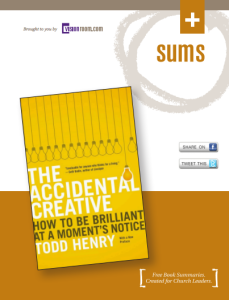
Three Ways to Unleash Creativity in Your Work
A leadership book I consistently recommend is Todd Henry’s The Accidental Creative: How to Be Brilliant at a Moment’s Notice. I first read it several years ago when I was new to my role at LifeWay.
In the last year, I’ve had to learn the hard way some life lessons about the creative process. In revisiting The Accidental Creative for a book discussion with some editor friends, I’ve been impressed with how many of the suggestions here, had I been more careful to take note and implement, would have helped me avoid some errors. More on that below . . .
The Creative Process
Henry wrote his book for those whose line of work might be considered “creative,” which he describes this way:
If you are one of the millions among us who make a living with your mind, you could be tagged a “creative.” Every day, you solve problems, innovate, develop systems, design things, write, think, and strategize. (1)
The gist of Henry’s book is that anyone can improve in their ability to generate good ideas on a consistent basis if they are more purposeful in their approach to the creative process.
A Caution
Now, a word of caution is in order—courtesy of singer-songwriter Andrew Peterson, whose superb new book, Adorning the Dark: Thoughts on Community Calling and the Mystery of Making , is out this month. Peterson recognizes a sinful tendency among people with an artistic temperament:
A few years ago I noticed that people had made a noun out of the word “creative,” as in, “If you’re a creative, aren’t you sick of people not understanding that normal rules don’t apply to you?” The first few times I read about “being a creative” I leaned into it and thought, “Yes. That’s what I am. I’m a creative.” It was subtle and seductive. And then I noticed, possibly because of the Holy Spirit, that I felt proud of it, which led to a sense of disdain for people who weren’t like me . . . (165)
Peterson believes “creativity” is a defining mark for all humanity, including his wife who, though not an artist, gave birth to three children and creates a certain atmosphere of hospitality in the home:
We’re all creative. There is no “creative class.” Sure, there are people who make their living as artists, entrepreneurs, and visionaries. But those people, I insist, are no more creative than anyone else. (166)
So, if you’re reading this article, you are “creative” in the broad sense, and if your primary vocation demands you spend time in design, writing, performing, strategizing, and so on, then you may be a “creative” in the narrow sense.
3 SUGGESTIONS FOR STRENGTHENING THE CREATIVE PROCESS
How can we create space for our creative process to thrive? Here are three suggestions.
1. Pay close attention to input and output.
Todd Henry puts it this way:
If you want to regularly generate brilliant ideas, you must be purposeful about what you are putting into your head. (22)
Is there water in the well? What are you filling your mind with? What activities are taking up your time? Is your creative energy suffering because you’ve run dry?
For me as a writer, there are two streams that must fill up the well I draw upon when I write or speak: reading and interaction. Reading, writing, and interaction depend upon each other.
- Reading is indispensable because, unless I am stimulating my mind with books and magazines, I am unable to write or speak when needed.
- Interaction matters because good conversations sharpen my thoughts and shape my decisions about what deserves further attention.
Interaction informs my reading, which fuels my writing. If any of those three elements slips, I dry up.
In Problems of Christian Leadership, John Stott recommended an hour of reading a day, as well as “a morning, afternoon or evening every week, that is to say, a longer period of about four hours.” Stott also recommended a “quiet day” once a month, which would involve reading, reflecting, and more distant planning. (If roughly 10 hours a week of reading seems impossible to you, look at your Screen Time to see how much time you spend on apps, and count up your hours of streaming TV a week.)
2. Turn everything off.
This suggestion is the one I struggle with the most. I’m an achiever who feels like I’m in performance mode all the time. I throw myself into project after project and feel a deep sense of satisfaction when I complete a task (although it’s usually short-lived because I’m already on to the next challenge!).
The trouble I face is in turning off the input valve and giving myself time to process what I’ve been reading, or the conversations I’ve been having. I’m tempted to always have the input valve open, so that a podcast or audiobook (at 1.5x speed!) fills my time in the car or when I’m out walking or doing household chores.
Todd Henry recommends we pay attention to our need for “negative space.”
The time between your active moments is when ideas are formed, insights are gained, mental connections are forged. If your life is a constant blur of activity, focus, and obligation, you are likely to miss critical breakthroughs because you won’t have the benefit of pacing and negative space. What’s not there will impact your life as much or more than what is. (130)
I hope to get better at building times of silence into my regular rhythms. Scrolling through Twitter or downloading more and more podcasts will likely weaken, not strengthen, the creative process. Without “negative space,” I may sacrifice my best work for busywork.
I should learn from the examples of some of my favorite writers, such as G. K. Chesterton and C. S. Lewis, who were known for taking long walks or spending hours in the garden in solitude. The brilliant analogies in Mere Christianity likely came to Lewis, not from listening to the radio all day, but as he strolled about the paths around the Kilns.
3. Plan in advance.
One of the upsides to the creative process, according to Henry, is that “you’re not really paid for your time” but “for the value you create.” The flipside is that this flexibility in how and where you do your work “introduces a new kind of performance pressure: completion anxiety.” Henry explains:
Because we’re capable of working at all times—our mind goes with us everywhere, after all—we continue working on our projects for as long as we possibly can. We’re never really certain when we’ve done enough. (28)
What’s the solution? Better planning. Henry writes:
Creative work requires that we stay ahead of our work. Tomorrow’s ideas are the result of today’s intentions. (116-117)
When I was serving as the primary teaching pastor at our church (preaching 40 times a year), I regularly delivered a rough draft of my sermon manuscript a month before the scheduled Sunday. There was simply no way for me to give my best creative efforts to something if I was haphazard or last minute in my thinking.
I still work this way. I’m constantly trying to get ahead in writing columns, or in preparing talks for conferences. Staying ahead of the work protects me from that awful feeling when I’m up against a deadline and there’s too little water to draw from in the well.
At the same time, all the planning in the world won’t give you endless energy when it comes to the creative process. One of the tough lessons I had to learn over the last year is that there was simply no way for me to continue my role as teaching pastor and write my next book. Something had to give, and in discerning my primary call, I chose to write. “Each commitment we make affects every other,” Henry says (121).
It’s not always a matter of maximizing your time, as if you’re a copy machine or a computer. It’s about creative energies and where you deploy them. And once you realize that creativity has a rhythm, with its own ebb and flow, you can begin to work with the rhythm rather than against it, recognizing the impossibility of being “limitless” in your output and instead embracing the right constraints and structure to help you succeed where God has placed you.

Tags: Creativity, The Accidental Creative, The Creative Process, Todd Henry, Trevin Wax
















